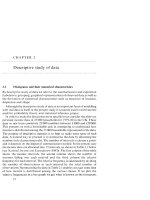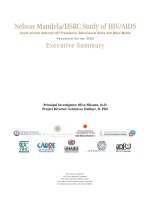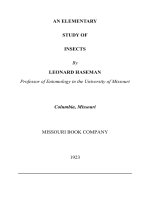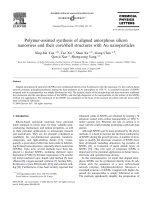Study of field emission characteristics of ultrathin film coated carbon nanotubes core shell structures 3
Bạn đang xem bản rút gọn của tài liệu. Xem và tải ngay bản đầy đủ của tài liệu tại đây (125.01 KB, 18 trang )
Chapter 3 Experimental Techniques
Chapter 3 Experimental Techniques
The principles of the experimental techniques employed in this research are described
in this chapter. These techniques include the CNT growth systems, thin film deposition
and preparation systems, thin film characterization techniques and field emission
testing apparatus.
3.1 Carbon Nanotubes Growth Techniques
In this section, magnetron sputtering and plasma-enhanced chemical vapor deposition
(PECVD) techniques will be briefly introduced. The magnetron sputtering technique
was used to deposit a layer of catalyst thin film on the substrate and the PECVD
system was utilized to grow the vertically-aligned CNTs.
3.1.1 Magnetron Sputtering
Sputtering is a physical vapor deposition and it is commonly used for thin film
deposition. Magnetron sputtering is one of the most versatile sputtering techniques
because it can be employed to deposit both insulating and non-insulating materials,
such as Ti, Mo, W, Al2O3, Fe, Co, AlN, Pt, FeNi, Ni, SiN, etc [1]. Moreover, it is
capable of producing thin films or coatings for diverse industrial applications, such as
hard coatings, semiconductor, optical and decorative films, etc [2].
33
Chapter 3 Experimental Techniques
The mechanism of the magnetron sputtering is very simple [3-6]. The plasma is
initiated between the cathode and the anode in the inert gas (typically Ar gas) at
pressures in the mTorr range by the application of a high voltage that can be either
direct current (DC) or radio-frequency (RF). RF mode is usually more widely used
than DC mode because it can avoid charge build up on the cathode, thus allowing
sputtering of insulators at much lower voltages and operation at lower Ar pressures.
The plasma is sustained by the ionization caused by secondary electrons emitted from
the cathode due to ion bombardment which are accelerated into the plasma across the
cathode sheath. The use of a magnetic field in the magnetrons behind the metal target
is capable of trapping electrons near cathode such that the plasma density will be much
higher, often by an order of magnitude or more, than a conventional DC diode
sputtering system. Furthermore, the number of electrons that reach the substrate
becomes fewer such that less heating is generated over the substrate.
In this study, a RF magnetron sputtering system Denton Discovery-18 was used
to deposit a layer of Fe thin film on the (100) silicon wafer to act as the catalyst for
CNT growth. The experimental procedures will be provided in details in Chapter 4.
3.1.2 Plasma-Enhanced Chemical Vapor Deposition
(PECVD)
Plasma-enhanced chemical vapor deposition (PECVD), also known as plasma
34
Chapter 3 Experimental Techniques
CVD or plasma-assisted CVD (PACVD) is a technique in which one or more gaseous
reactors are used to form a solid thin film layer on the substrate surface at lower
temperatures. There are some chemical reactions involved in the process which occur
after creation of plasma of the reacting gases. The plasma is generally created by RF
(typically 13.56 MHz) or DC discharge between two electrodes in the presence of
reactive gases [7, 8].
PECVD uses electrical energy to generate a glow discharge in which the energy is
transferred into a gas mixture. This transforms the gas mixture into reactive radicals,
ions, neutral atoms and molecules and other highly excited species. These atomic and
molecular fragments interact with a substrate and either etching or deposition processes
occur at the substrate depending on the nature of these interactions. Since the formation
of the reactive and energetic species in the gas phase occurs by collision in the gas
phase, the substrate can be maintained at a low temperature. Hence, film formation can
occur on substrate at lower temperatures than in the conventional CVD process, which
is a major advantage of PECVD [9-11]. Some of the desirable properties of the films
grown by PECVD technique are good adhesion, low pinhole density, good step
coverage and uniformity.
Currently, PECVD is extensively used in semiconductor manufacturing to deposit
films onto wafers containing metal layers or other temperature-sensitive structures for
electronic, industrial and medical use, such as SiO2, SiNx, SiON and amorphous
silicon [8].
35
Chapter 3 Experimental Techniques
In this study, PECVD has been employed to grow high density vertically-aligned
CNTs, which were used as substrate for thin film deposition.
3.2 Thin Film Deposition and Preparation Systems
This section introduces the principles of metal-organic chemical vapor deposition
(MOCVD) and pulsed laser deposition (PLD) techniques. In this project, these two
custom-designed systems were used primarily to deposit metal oxide and amorphous
carbon ultrathin films onto the pristine CNT substrates. In addition, the microwave
plasma CVD system, which was used to prepare the hydrogen terminated amorphous
carbon/CNTs specimens, will be introduced in 3.2.3 as well.
3.2.1
Metal-Organic
Chemical
Vapor
Deposition
(MOCVD)
Metal-organic chemical vapor deposition (MOCVD) is a relatively newcomer for
the CVD technique, as its first reported use was in the 1960s for the deposition of
indium phosphide and indium antimonide [12]. These early experiments demonstrated
that deposition of critical semiconductor materials could be carried out at lower
temperatures than conventional thermal CVD and that epitaxial growth could be
successfully achieved. The quality and complexity of the equipment and the diversity
and purity of the precursor chemicals have steadily improved since then and MOCVD
36
Chapter 3 Experimental Techniques
is now used largely and particularly in semiconductor and opto-electronic applications.
Formation of a thin film by MOCVD is based on the thermal decomposition of a
metal-organic precursor in a flow of carrier gas [13]. More specifically, the MOCVD
growth is achieved by introducing metal-organic source materials into a reactor
chamber, which can be either a quartz tube or a stainless steel chamber that contains a
substrate placed on a heated susceptor. Metal-organics are compounds in which the
atom of an element is bound to one or more carbon atoms of an organic hydrocarbon
group. When the metal-organic gas molecules pass over a hot substrate, the heat breaks
up the molecules and deposits the desired atoms on the surface layer by layer. Generally,
three types of heating methods have been used to heat the susceptor: RF induction
heating, radioactive heating and resistance heating. Most MOCVD reactions occur in
the temperature range of 300 - 800 °C and at pressures varying from less than 1 Torr to
atmospheric pressure. The main factors determining the film deposition rate and
properties are the nature of the metal-organic reagent, the temperature of the substrate,
the rate of metal-organic transport and the impurities introduced into the system.
MOCVD technique has advantages compared with non-CVD and other CVD
techniques of film formation. By employing all starting materials in the vapor state in a
simple cold-wall reactor having only one heated temperature zone, this technique
allows the economic and highly productive deposition of uniform and adhesive films at
low substrate temperatures, as well as the elimination of auto doping and impurity
incorporation from the reactor walls [14].
37
Chapter 3 Experimental Techniques
3.2.2 Pulsed Laser Deposition (PLD)
Pulsed laser deposition (PLD) is a technique used to deposit high quality films
for more than two decades. This technique was introduced in 1960’s and kept on
developing with the step of high energy laser technology [15]. In 1984 and 1985, the
excimer laser was utilized to get shorter pulse duration and high pulse energy, which
were found to be favorable for better film quality and higher deposition rate. In 1987,
PLD was first successfully applied in the fabrication of high Tc superconducting
(HTS) thin films [16].
PLD technique uses high power laser pulses (typically ~108 W cm-2) to melt,
evaporate and ionize material from the surface of a target. This ablation process
produces a transient, highly luminous plasma plume that expands rapidly away from
the target surface. The ablated material is collected on an appropriately placed
substrate upon which it condenses and the thin film grows.
PLD technique has several advantages over other film deposition methods,
including: [17]
(1) Laser-induced expulsion produces a plasma of material with stoichiometry
similar to the target;
(2) It is capable of real-time, mono-layer deposition;
(3) Many materials can be deposited in a wide variety of gases over a broad
range of gas pressures;
(4) High quality samples can be grown reliably within 10 or 15 minutes.
38
Chapter 3 Experimental Techniques
(5) Deposition can be conducted at room temperature.
Applications of the PLD technique range from the production of superconducting
and insulating circuit components to improved wear and biocompatibility for medical
applications.
3.2.3 Microwave Plasma CVD System
The microwave plasma CVD technique is used worldwidely to grow various
materials, including carbon and carbon related materials (diamond, nanocrystalline
diamond and CNTs, etc.) and non-carbon advanced materials, such as GaN, SiC, Ga2O3
and silicon whiskers [18].
The microwave plasma is generally provided with a frequency of 2.45 GHz. Its
unique property is the capability to oscillate electrons at microwave frequency.
Typically at 10 to 100 Torr chamber pressures, the electrical discharge can be
sustained by the microwave radiation. As a result of electrons colliding with gas
atoms and molecules, high ionization fractions are generated and the inlet gases
(carbon containing gases or hydrogen gas) are then dissociated within such a
discharge. Due to the stability and reproducibility of the microwave non-isothermal
plasma, film deposition can be carried on for a long duration [19, 20]. These features
make microwave plasma CVD an excellent tool for diamond or diamond-like carbon
(DLC) fabrication.
39
Chapter 3 Experimental Techniques
In this study, a microwave plasma CVD system was used to conduct the
hydrogen plasma treatment on the DLC coated CNTs specimens.
3.3 Thin Film Characterization Techniques
Characterization techniques of thin films utilized in this project will be briefly
introduced in this section, including scanning electron microscopy (SEM),
transmission electron microscopy (TEM),
X-ray diffraction (XRD),
X-ray
photoelectron spectroscopy (XPS) and ultraviolet photoelectron spectroscopy (UPS).
3.3.1 Scanning Electron Microscopy (SEM)
Scanning electron microscope (SEM) is a technique that is widely utilized to
investigate the surface morphologies of materials. It takes images of the sample
surface by scanning with high-energy beam of electrons in a raster scan pattern. The
high-energy electrons are usually emitted via field emission, and they are formed by
an electron gun via being accelerated toward the sample using a positive electrical
potential. The electron beam (several or tens of keV) is focused onto the sample by a
series of magnetic lenses and a scanning coil moves the beam across the sample
surface. The electron beam actively interacts with the surface atoms of the sample,
generating signals that contain particular information about the sample’s surface
topography, composition and so forth. Typically the most important produced signal is
40
Chapter 3 Experimental Techniques
the secondary electrons, which are collected by a low-energy (< 50 eV) secondary
electron detector. This secondary electron imaging can produce high-resolution
images of the sample surface, demonstrating structure details less than 1 nm in size.
Additionally, SEM can also provide three-dimensional information of the sample due
to the large depth of the field yielded by the extremely narrow electron beam. These
characteristics particularly enable SEM to reveal the microstructure of sample surface
without any physical or chemical destruction. The taken images are produced on a
cathode ray tube display [21, 22].
Surface morphologies of the samples in this study were characterized by a
PHILIPS XL30-FEG (Field Emission Gun) SEM equipped with an Ion Getter Pump
(IGP), which enables the normal working pressure for the source to achieve about 2 ×
10-9 Torr or better.
3.3.2 Transmission Electron Microscopy (TEM)
Transmission electron microscopy (TEM) is a technique used to obtain very
high-resolution images and diffraction patterns of the specimen. Crystal lattice images
can be easily observed in a modern TEM, and the lattice spacing can be determined as
well. TEM is different with SEM in principle in that TEM emits an electron beam that
transmits through an ultrathin specimen. A TEM image is formed when the
transmitted electrons interact with the specimen as they pass through. Although TEM
41
Chapter 3 Experimental Techniques
cannot provide sample depth profiles as SEM due to the direct transmitted electron
projection, it is capable of providing a much higher resolution, which is necessary for
atomic level microstructure detection.
A JEOL-2010 model high-resolution TEM (HRTEM) at an accelerating voltage
of 200 KV was used to investigate the nanostructures of the samples in this research.
3.3.3 X-ray Diffraction (XRD)
X-ray diffraction (XRD) is a non-destructive analytical technique which reveals
the information about the crystallographic structure, chemical composition and
physical properties of materials. When impinging on a crystalline structure, an
incident X-ray will be diffracted if the X-ray beams are scattered by adjacent crystal
planes in phase (constructive interference). Diffraction patterns showing peaks and
intensity of various crystallographic textures can then be obtained and analyzed as
shown in Fig. 3.1. The concept behind crystal diffraction is Bragg’ law: [23]
nλ = 2d sinθ
(3.1)
where n is the integer representing the order of diffraction, λ is the wavelength, d is
the interplanar spacing of the reflecting (diffracting) plane, and θ is the angle of the
incidence and of the diffraction of the radiation relative to the reflecting plane.
42
Chapter 3 Experimental Techniques
Fig. 3.1 Schematic principles of Bragg's law.
In this study, XRD spectra of the samples were obtained with a BRUKER AXS
(model D8 ADVANCE, λCu,Ka = 0.154060 nm) system at 40 kV and 40 mA. The data
was acquired with a BRUKER AXS software named as XRD commander and
analyzed by the Eva software. Identification of the peaks was achieved by comparing
the obtained patterns with an internationally recognized database JCPDS
(International Centre for Diffraction Data).
3.3.4 Photoemission Spectroscopy
Photoemission spectroscopy uses photo-ionization and analyses the kinetic energy
distribution of the emitted photoelectrons to investigate the composition and electronic
state of the surface region of a sample. The principle is based on the photoelectric effect
developed by Einstein in 1905 where the concept of the photon was used to describe the
ejection of electrons from a surface when photons impinge upon it. Traditionally, the
43
Chapter 3 Experimental Techniques
technique is subdivided into X-ray photoelectron spectroscopy (XPS) and ultraviolet
photoelectron spectroscopy (UPS) according to the sources of exciting radiation in that
XPS uses soft X-rays (with a photon energy of 200 - 2000 eV) to examine core-levels
whereas UPS uses vacuum ultraviolet (UV) radiation (with a photon energy of 10 - 45
eV) to examine valence levels [22, 24].
3.3.4.1 X-ray Photoelectron Spectroscopy (XPS)
X-ray photoelectron spectroscopy (XPS) is a widely used non-destructive (except
depth profiling) technique to quantitatively investigate the elemental composition,
empirical formula, chemical and electronic states of almost every element (except H
and He) on a material surface [25]. The primary excitation is accomplished by
irradiating the specimen with a monochromatic X-ray source, typically Mg Kα
(1253.6 eV) or Al Kα (1486.6 eV) soft X-rays to induce photoionization of atoms in
the specimen. The energy spectrum of the emitted photoelectrons is then detected and
analyzed. The underlying principles are schematically demonstrated in Fig. 3.2.
The kinetic energy (Ek) of the emitted electrons are measured by an electron
energy analyzer and the XPS spectrum obtained is usually a plot of the number of
detected electrons per energy versus their binding energies (EB), given by: [25, 26]
Ek = hυ − EB − φ
(3.2)
where hυ is the energy of the photon and Ø is the work function of the spectrometer.
44
Chapter 3 Experimental Techniques
Fig. 3.2 Schematic illustration of XPS photoemission process.
Each element possesses a unique spectrum. The spectrum of a mixture of
elements is approximately the sum of the peaks of the individual constituents.
Generally, identification of chemical states can be made from exact measurements of
peak positions and separations, as well as from certain spectral features. In the XPS,
the composition of the film can be measured by utilizing peak area and peak height
sensitivity factors. Chemical shifts, ranging from 0.1 to 10 eV or more in magnitude
occur when the core-level atoms are sufficiently affected by their chemical
environment [25]. These shifts arise from the variation of electrostatic screening
experienced by core electrons as they are drawn towards or away from the interested
atom.
In this study, XPS analysis of the samples was carried out using a Kratos DLD
Ultra UHV spectrometer. A monochromatized Al Kα X-ray source (1486.6 eV photons)
45
Chapter 3 Experimental Techniques
with a spot size of about 1 mm was used for XPS measurements. Core-level XPS
spectra were obtained by photoelectrons at a take-off angle of 90°, measured with
respect to the sample surface at a vacuum of 5 × 10−9 Torr. XPS spectra were
collected in a concentric hemispherical analyzer in a constant energy mode, with a pass
energy Ep of 20 eV.
3.3.4.2 Ultraviolet Photoelectron Spectroscopy (UPS)
Ultraviolet photoelectron spectroscopy (UPS) is a technique used to determine
the kinetic energy spectra of photoelectrons emitted by UV photons and to study the
molecular energy levels in the valence region. Its principle is similar with that of XPS
except that in XPS the photon is absorbed by an atom in a molecule or solid, leading to
ionization and emission of a core (inner shell) electron whereas in UPS the photon
interacts with valence levels of the molecule or solid, leading to ionization by removal
of one of these valence electrons.
In UPS the source of radiation is normally a noble gas discharge lamp,
frequently a He-discharge lamp emitting He (I) radiation of energy 21.2 eV. Such
radiation is only capable of ionizing electrons from the outermost levels of atoms - the
valence levels. The advantage of using such a UV radiation over X-rays is the very
narrow line width of the radiation and the availability of high flux of photons from
simple discharge sources.
Although UPS is difficult to be used quantitatively as XPS due to its UV
46
Chapter 3 Experimental Techniques
radiation source, it is particularly used to study the bonding at sample surfaces since
the valence electrons are involved in chemical bonding. UPS readily provides
measurements of the work functions and band structures of the solid, the surface and
adsorbed layers [27, 28].
In this study, UPS technique was used to measure the work functions of the
samples. Photons of the He (I) resonance line (21.2 eV) through a helium cold
discharge were used. While obtaining the UPS spectra, the analyzer energy was set to
be 120 meV with the acquisition time per spectrum of ~150 s.
3.4 Field Emission Apparatus
Field emission testing of the samples was carried out with a custom-designed field
emission system, using parallel plate geometry at room temperature. The
emitter-to-anode distance was maintained at 100 µm by inserting a polymer film spacer,
on which a hole with a fixed area was fashioned to define the total emission area. The
chamber was pumped down to a base pressure of 1 × 10-6 Torr. The field emission
current-voltage (I-V) relationship was obtained by applying a DC field between the
sample and anode. Emission current was measured using a Keithley 237 source
measurement unit. The leakage current was also measured by reversing the applying
voltage.
47
Chapter 3 Experimental Techniques
Fig. 3.3 shows a schematic structure of the sample stage for field emission testing.
The sample was placed on a small protruding metal stage. At each testing, samples
were put at the same place. The spacer with fixed thickness was placed on top of the
samples to make sure the distance between the emitters and the anode was constant.
Two clips were used to fix the position of the anode and spacer. The clips were
controlled to be just tight enough to prevent sliding of the spacer but not too tight to
press or distort the spacer.
Anode
Spacer
Glass
Cathode
Metal stage
Glass
Sample
Fig. 3.3 Schematic illustration of the sample stage for field emission testing.
48
Chapter 3 Experimental Techniques
References
1.
H. J. de los Santos, Principles and Applications of NanoMEMS Physics (Springer,
Netherlands, 2005) pp. 15.
2.
S. Zhang and N. Ali, Nanocomposite Thin Films and Coatings: Processing,
Properties and Performance (Imperial College Press, London, 2007) pp. 348.
3.
A. A. Tracton, Coatings Technology: Fundamentals, Testing, and Processing
Techniques (CRC Press, 2006).
4.
/>
5.
M. H. Francombe and J. I. Vossen, Plasma Sources for Thin Film Deposition and
Etching (Academic Press Limited, USA, 1994).
6.
/>
7.
M. D. Allendorf, M. R. Zachariah, L. Mountziaris, and A. H. McDaniel,
Fundamental Gas-Phase and Surface Chemistry of Vapor-Phase Materials
Synthesis (The Electrochemical Sociery, Inc., USA, 1999) pp. 167.
8.
/>
9.
R. F. Bunshah, Handbook of Deposition Technologies for Films and Coatings:
Science, Technology, and Applications (Noyes Publications, 1994).
10. M. Meyyappan, L. Delzeit, A. Cassell, and D. Hash, Plasma Sources Sci. Technol.
12, 205 (2003).
11. D. M. Mattox, Handbook of Physical Vapor Deposition (PVD) Processing: Film
Formation, Adhesion, Surface Preparation and Contamination Control (Noyes
Publications, USA, 1998) pp. 7.
12. M. Razeghi, The MOCVD Challenge (Institute of physics publishing, 1995).
13. C. E. Morosanu, Thin Films by Chemical Vapor Deposition (Elsevier, 1990).
14. W. S. Rees, Jr., CVD of Nonmetals (VCH publishers, 1996) pp. 424.
15. H. M. Smith and A. F. Turner, Appl. Opt. 4, 147 (1965).
16. D. Dijkamp, T. Venkatesan, X. D. Wu, S. A. Shaheen, N. Jisrawi, Y. H. M. Lee,
49
Chapter 3 Experimental Techniques
W. L. McLean, and M. Croft, Appl. Phys. Lett. 51, 619 (1987).
17. D. B. Chrisey and G. K. Hubler, Pulsed Laser Deposition of Thin Films (Wiley,
New York, 1994).
18. />19. R. Chattopadhyay, Advanced Thermally Assisted Surface Engineering Processes
(Kluwer Academic Publishers, USA, 2004) pp. 152.
20. H. Liu, and D. S. Dandy, Diamond Chemical Vapor Deposition: Nucleation and
Early Growth Stages (Noyes Publications, USA, 1995) pp. 26.
21. R. W. Cahn and E. Lifshin, Concise Encyclopedia of Materials Characterization
(Pergamon Press, 1993).
22. C. R. Brundle, C. A. Evans, and S. Wilson, Encyclopedia of Materials
Characterization: Surfaces, Interfaces, Thin Films (Elsevier, 1992).
23. B. D. Cullity and S. R. Stock, Elements of X-Ray Diffraction (Prentice-Hall,
International, 2001).
24. />25. J. F. Moulder, W. F. Stickle, P. E. Sobol, K. D. Bomben, Handbook of X-Ray
Photoelectron Spectroscopy (Perkin-Elmer Corporation, USA, 1992).
26. L. Diederich, O. M. Küttel, P. Aebi, and L. Schlapbach, Surf. Sci. 418, 219
(1998).
27. Kurt W. Kolasinski, Surface Science: Foundations of Catalysis and Nanoscience
(Wiley, UK, 2008) pp. 97.
28. D. J. O'Connor, B. A. Sexton, and R. St. C. Smart, Surface Analysis Methods in
Materials Science (Second edition, Springer, USA, 2003) pp. 337.
50









